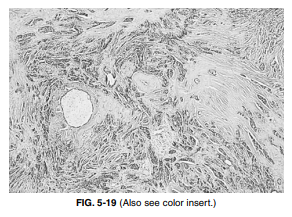A 46-year-old obese woman has had symptoms of vulvovaginitis for the past 9 months that is found to be caused by Candida. Laboratory tests reveal proteinuria and glucosuria, and increased serum glucose, BUN and creatinine. If a renal biopsy were performed, which of the following would be the most likely light and electron microscopic findings, respectively, in the glomeruli?
(A) hypercellularity with thickened basement membranes (GBM); duplication of GBM
(B) hypercellularity with PMNs; subepithelial deposits
(C) normocellularity with thickened GBM; subepithelial deposits
(D) normal morphology; loss of epithelial foot processes
(E) thickened GBM; no deposits
A 21-year-old previously healthy man had a headache, malaise, and low-grade fever for the past 4 days. He was brought to the emergency room this morning after he started behaving in an unusual manner and experienced difficulty in speaking. While he was being transported, he suffered a generalized seizure. Physical examination showed a fever of 103°F and total disorientation. Deep tendon reflexes were exaggerated and the plantar response was bilaterally extensor. He had mild neck stiffness and the optic fundi showed early papilledema. A lumbar puncture produced clear CSF under an opening pressure of 300 mm H2O. Protein was 160 mg/dL, glucose 66 mg/dL (blood glucose 90 mg/dL), and there were 32 mononuclear cells/μL. No PMNs were present. Which of the following is the most likely cause of this man’s condition?
(A) glioblastoma multiforme
(B) herpetic meningoencephalitis
(C) meningioma
(D) meningococcal meningitis
(E) spontaneous cerebral hemorrhage
(F) subarachnoid hemorrhage
A 53-year-old woman recently noticed a firm, 2-cm nodule in her right breast during monthly self-examination. The histology of her breast biopsy tissue is displayed in Figure 5-19. Which of the following is an adverse prognostic indicator that may be seen with this disorder?

(A) estrogen receptor positive
(B) low S phase
(C) overexpression of Her2/neu oncogene
(D) progesterone receptor positive
(E) well-differentiated histology, grade I of II
The prevalence for disease X is 1%. A new laboratory test is positive in 99% of the patients with disease X, but half of the total of positive test results obtained correspond to patients without disease X. Based on this information, the test would be classified as which of the following?
(A) sensitive and nonspecific
(B) sensitive and specific
(C) nonsensitive and nonspecific
(D) nonsensitive and specific
Approximately 6 months ago, a 59-year-old man developed a dull, continuous abdominal pain that radiated to the right upper quadrant and was relieved by bending forward. He has also had recurrent thrombophlebitis. He now develops jaundice. Of the following, which is the condition that would most likely explain all of these findings?
(A) alcoholic cirrhosis
(B) cholecystitis
(C) cholelithiasis
(D) pancreatic adenocarcinoma
(E) viral hepatitis
Students succeed in their courses by connecting and communicating with an expert until they receive help on their questions

Consult our trusted tutors.